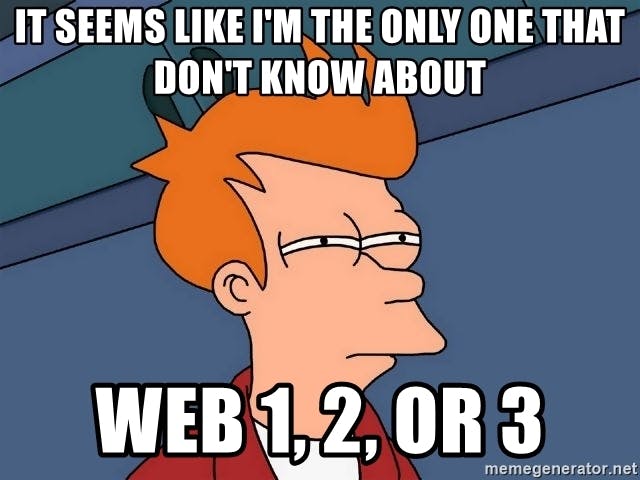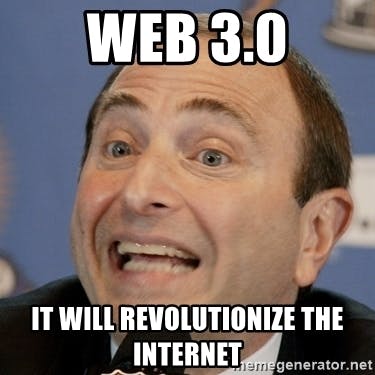This is the new chapter of the internet everybody is talking about it, everyone wants to build on it, there is this new shift to this stage, some people think its a revolution, some think its an evolution, some think it is all just trash, and there are others that don't even know what it is why all the buzz around it. So "WHAT IS WEB 3 AND WHY SHOULD YOU CARE?"😕🤨.
Now let's go back to the beginning.
Time Travel⏰✈

Since the inception of the internet and its progression, the internet has always been changing with different points of progression. This progression so far has been divided into three different stages.
- Phase one - Web 1.0
- Phase two - Web 2.0
- Phase three - web 3.0
Phase One - Web 1.0
This is the first stage or chapter in the progression of the internet, it was created by Tim Barners Lee between the 1980s - early 2000s. This chapter of the web was mostly characterized by providing the audience with daily content. Web 1.0 was characterized with static HTML content and file system, web pages were built using Common Gateway Interface (CGI) or Side Server Includes (SSI) .
Web 1.0 was a Read-Only Web, the audience could not interact or contribute to the content posted, they could only read. It was built with the sole purpose of information sharing. People tend not to visit the same site regularly because the content never change and might remain the same way for years. The Web was boring 😐😑🥴.

Phase Two - Web 2.0
This stage of the web is where we are today, it was built as an improvement to Web 1.0. It is referred to as the “Read-Write Web”, in this stage of the internet users cannot only read information, they can also interact, contribute and create content easily on the internet. Web 2.0 is largely dominated by the four behemoths — Facebook, Apple, Google, and Amazon.
Here, we can express ourselves and share our ideas, interact with other people's content by commenting and liking, apart from interacting we could also share other people's content. Web 2.0 has an amazing user interface and experience, it is built on some solid programming languages such as HTML, CSS, Javascript, etc.
Due to the dynamic and interactive nature of web 2.0, we saw great innovations take place such as the creation of smartphones, smart TVs, better models of computers. There was a massive creation of mobile and web apps built by the four behemoths to enable the user to easily communicate and interact with the internet without stress. Everything here seemed perfect why should there be an improvement on this?
Web 2.0 had a major flaw, it had a centralized structure, which means it had a centralized database system. This means you have no control over your data, how your data is used, or where it is stored. It is being controlled by leading digital platforms, these platforms make a heavy profit off your data by selling it, which means less privacy, security, and control of your data online.
Another major problem with this centralized system is that it can be easily breached. If the centralized server crashes or goes down so will the other applications attached to it. For example, If AWS goes down today more than half of the internet will go down with it. This is a major issue and this is what gave rise to Web 3.0

Phase Three - Web 3.0
This is the future of the internet the term was created by Ethereum co-founder Gavin Wood in 2014. At this point the internet is not governed by centralized bodies, rather it is shared ad governed by a collective. This period brings about a shift in the internets products so that it benefits the user rather than large co-operatives. It is characterized by a decentralized system and data is not stored in a central database, it is distributed using a peer-to-peer system across different nodes.
According to an article from coinbase, it states that Web 3.0 data will be interconnected in a decentralized way, this would be a large revolution to our current generation of the web, where data is mostly stored in centralized repositories.
This simply means that there is no central authority governing the users' data or how it is used, we the users have total control over our data how it is used and stored. Some amazing benefits and advantages of web3 are:
- Quick Transaction: Because there is no interference of transaction and interaction by a middleman transactions are carried out faster.
- Secure: Here your data and privacy are 100% secured, you have total control of your data.
- Permissionless: Users and suppliers, can participate without authorization from a governing body.
- Trustless: Users can interact with the web without third-party interference.
- Decentralized: Web 3.0 is also referred to as a decentralized web, this implies that everything that takes place in web 3.0 happens without central authority access to control the system.
Web3 applications do not run on a single server, instead, they use blockchain technology and a decentralized network of peer-to-peer nodes. Thereby making it highly secured and difficult to hack.

Blockchain⛓⛓
Blockchain is a decentralized system, data on the blockchain is not governed by a central authority. A Blockchain is a system that assembles and stores structured information and distributes it across the entire network of computer systems connected through peer-to-peer nodes. This assembling of structured information is known as - Digital Ledger. The distribution and storage of data across computer nodes are what make it very secure.
Distributed Ledger Technology (DLT).
For a transaction to be carried out on the digital ledger, it has to be authorized by the digital signature of the owner, and a record of that transaction is distributed to every participant's ledger on that chain. This is the process of managing these decentralized databases by multiple participants or computers.
Blockchain is not the only type of distributed ledger, there are others but others don’t make use of the chain of connection like blockchain.
Crypto wallet
Asymmetric cryptography is the base of web3 and distributed ledger. This is the use of pair of related keys a public key and a private key, these pair keys are used to encrypt and decrypt a message to protect it from unauthorized access.
A Crypto wallet is like a password manager that manages private keys for your wallet address. With a crypto wallet, you can send and receive your digital assets such as tokens and NFTs. Technically crypto wallets do not store any of your transaction data, this data is there on the blockchain and can be accessed only with the use of your private key. A crypto wallet consists of:
Address: This represents your account on the blockchain. It is consist of a string of text generated using asymmetric cryptography. An example of a wallet address is: 0x690DF5E3058974f5cA67AA4D3705e4cF940a1E61
Private key: your private key is like a password to your account on the blockchain that helps you access your crypto wallet. An example is L9873D79B6D87DC0FB6A5778633389F4453210003DA61F20BD67QC233GG33262
Seed Phrase: this is a master password. A seed phrase consists of a bunch of random words generated by your crypto wallet to help you access your crypto wallet, every seed phrase is unique for each wallet. An example of a seed phrase is “donkey plumber private board old slim kit explain rubber regular head physics”. Always remember that your seed phrase should not be shared with anyone.
Some trusted crypto wallets are: Metamask Coinbase Trust Wallet Atomic Wallet
Uses of a crypto wallet
- Manage all your digital assets
- Control your private keys
- Send and receive cryptocurrency
- Easy transaction
- Access decentralized applications (dApps)
What are dApps - Decentralized Applications
A decentralized application or dApps is an application like the mobile and desktop app that is powered by a decentralized peer-to-peer network. These applications are not governed by a centralized system and they do not run on a central server. Here the user has total control of the app. For this to be possible Ethereum would power an automated if-then statement known as smart contracts.
Characteristic of dApps
- A dApp must work without third-party intervention. It must have an open-source code
- It must be controlled by the user, here changes are voted for before being implemented.
- It must have a cryptographic token for access
- Miners and stakers must be rewarded.
- On Ethereum, DApp has a consensus method that generates tokens which is proof-of-work (PoW). this will later be improved in the newer version of Ethereum (eth 2.0) to proof-of-state (PoS)
- Decentralization is the main concept here so all data must be stored in a publicly accessible blockchain network
Smart contracts
These are computer programs that are processed and distributed on all nodes on the Ethereum network. It does not have a central coordinator. A smart contract establishes the term of an agreement, instead of a written agreement, a smart contract is executed as a code on the blockchain. A smart contract allows you to program contracts that can be executed by the computer code.
Smart contracts are not controlled by the user, they are deployed on the network and run as programmed. The way a user can interact with the smart contract is when executing a transaction.
Smart contracts cannot be separated from web 3.0, it is a major part of this point in the progression of the internet, this is because smart contracts create an ecosystem of decentralized protocols by interacting with other smart contracts and this decentralization is what web3 is based on.
Conclusion
From all we have stated above, we can see that web3 came to benefit us the users, and to give us total control of our data. Also, in the web3 stage transaction are faster, the internet experience is more personalized, and so many other advantages of a decentralized system. Web 3.0 will bring about the establishment of a more balanced Web.
